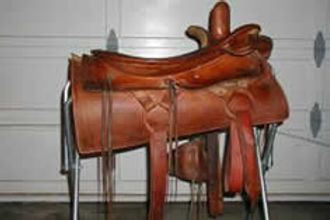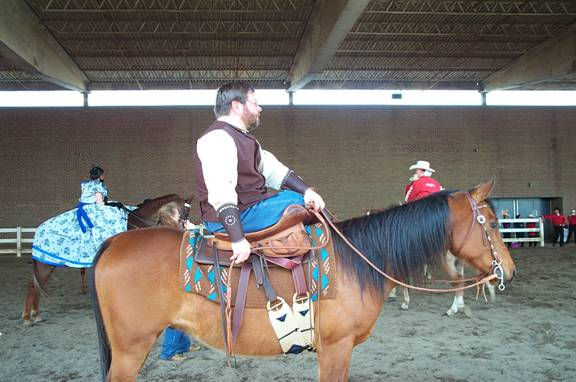By Linda Flemmer
Background
Rigging
The rigging rings on 19th century saddles were made of forged iron round stock which would rust if exposed to the elements and horse sweat. The iron oxide would rot the leather it touched, causing the rigging straps holding the rings to fail. To prevent this disaster, saddlemakers of the era covered the metal rings in 4-5 ounce (medium thickness) belly leather. This was the case until approximately 1915 when brass rigging hardware became more common. The saddles pictured in this article demonstrate leather covered iron rigging rings. (Figures 1, 2 & 4)
The Goodnight-style saddles almost always had a dainty tapadero stirrup that protected the foot from brush in rough country. It also served to keep the rider's foot from

Charles and Mary (Molly) Dyer Goodnight
Charles Goodnight, a prominent Texas rancher and cattleman developed a working western side saddle in the 1870's for his first wife, Mary (Molly) Dyer Goodnight. The West was too rough for the carriages used for ladies' transportation in the East and they were not practical for ranch work. The saddle had to meet the requirements of daily riding and work on the range as well as fit a variety of horses on a day to day basis. (Photos of the Goodnights compliments of Amarillo Public Library.)
English and catalog side saddles of the period were certainly available in the United States – many of these saddles had flocked panels. Some few included leaping heads. Seats ranged from a large flat western pan seat to a slightly dipped seat to a "C" shaped, sharply dipped seat front to back, many with carpeting or cloth. These saddles did not meet the needs of a sturdy working saddle in the West. Flocked panels required regular restuffing to the individual horse's conformation. Fabric seats were not terribly durable and when caught in the rain or soaked in a river crossing, they became sodden and were slow to dry. Repairs required a different skill set than the average ranch hand was apt to have. Catalog saddles were produced cheaply and usually lacked the safety of a leaping head.
The Goodnight Design
The saddle that Charles Goodnight designed was based on working western saddles of the time. It included a leaping head for added security. The trees used western bars and were rawhide covered for additional strength. Western bars were more forgiving in fit for a number of different horses rather than requiring the custom flocking of English panels. The saddles had heavy, square double skirting and fleece lined undersides. The rear jockeys were laced to allow for some independent movement as the horse's hind quarters movement.
Mr Goodnight commissioned a side saddle with SC Gallup of Peublo, Colorado in June of 1870, expecting to have the saddle ready to present to his new bride. (Texas Women on the Cattle Trail, S.R. Massey). The first mention of Molly Goodnight riding the saddle her husband had designed was during their travel to the Panhandle of Texas in 1887. (Handbook of Texas, University of Texas at Austin; Panhandle-Plains Historical Museum) The saddle style was quickly adopted, with a variety of manufacturers making a version within the next 10 years.
Typical of the era, there is a vestigial horn near the right knee. Some of these working saddles have a handle under the right vestigial horn – a "grab handle", "panic strap" or "nightlatch" for added security when the horse begins to get "cowy" and work the cattle with fast changes in direction. (Just visible in Figure 2) The seats are slightly uphill compared to old name English side saddles to accommodate the lack of a cutback gullet. (Figure 1) They do not take this uphill cant to the extremes often seen in modern, low quality western sidesaddle reproductions.

Seats
The seats of the Goodnight saddles are typically leather rather than fabric, suede or doeskin. As seen in the picture of my Steelbound saddle, the seats often had a pattern stamped into the leather to improve the grip as well as for décor. (Figure 3) My Great West Saddlery saddle was restored by an unknown saddle maker using suede. This is most likely not historically accurate, but makes for a very nice ride under dry conditions. (Figure 4) As with almost all the vintage & antique side saddles, you will note that the seat is not symmetrical! The left side swirls out to support the riders left hip. The seats themselves were generally flat through the cantle rim area or only slightly built up, allowing the rider freedom of movement in the saddle rather than "hemming her in". (Figures 3 & 4)

Figure 1: Slight uphill
Figure 2: Grab handle on offside

Figure 3: Stamped pattern shown on seat
Figure 4: Suede seat on restoration
accidentally pushing too far thru the stirrup and becoming entrapped. The Goodnight saddles' tapaderos also show an extension of leather against the horse's side to protect the lady's shoe from becoming soiled. The leather of the tapadero is placed around a bent wood stirrup. I was fortunate to find the original tapadero stirrup with my Steelbound. (Figure 1)
The Goodnight saddle is invariably a double rigged saddle, meant to be used with two cinches (cinchas with a connecting strap to keep the rear girth from migrating back to become a bucking strap! When girthed this way, the saddle can still experience some shimmy or "walk" in the rear, despite the rear girth being brought up snugly against the horse rather than hanging loosely as on an astride saddle's flank cinch. The double girthing system is simply not as secure as a balance strap on a more modern saddle. One way to remedy this follows:
Use a half-breed latigo (single thickness short strap with punched holes) on the near side front rigging ring. Attach your string girth to one of the upper holes and take it up using a regular latigo strap on the front off side. Attach your second string girth to the same near side half-breed latigo on a lower hole. Take it up with a regular latigo on the rear off side rigging ring. The second string girth now functions as a wide balance girth without altering your historical saddle. The angle of the second "balance" girth is such that you should not need a connecting strap between the two. (Figure 5), Mike Flemmer up on TBM Gem's Song (Razz) on the Great West saddle.)

Figure 5: Mike Flemmer aside on Razz
The Steelbound I've pictured (Figures 1, 2, 3) has been dated to between 1900 and 1905. The brand has been documented in publications of vintage saddles, but no dates or specific saddlemakers are known to me. I have personally seen one other Steelbound Goodnight-style western sidesaddle in a darkerleather.
The Great West saddle (Figure 4) was built by the Great West Saddlery, Calgary, Northwest Territories (Canada). This company, the largest harness and saddle-making company in the West at the turn of the 20th century, made many of the saddles used by western ranchers of the period as well as the Canadian Mounties. It is the only sidesaddle I've seen made by this company. The saddlery stamps on the corners of the original skirting date the saddle to between 1902 and 1903.


